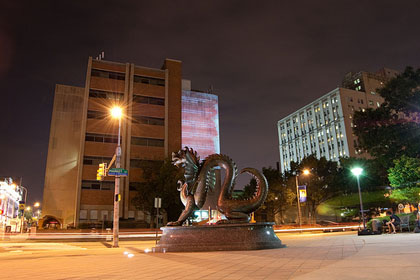
It was only a matter of time until Philadelphia’s graffiti scene was given a digital upgrade.
At least, that was the thinking behind Drexel University’s Social Graffiti project, which projected digital animations and interactive messages on the side of the university’s Nesbitt Hall early this month.
Team leader Matthew Morton, who just graduated last week with a bachelor’s in digital media from Drexel, worked with five other members of the media school to develop the project. Inspired by Comcast Center’s video wall, the team used 3D animation and videography techniques to creatively—and temporarily—alter the building’s facade.
Optical illusions, like one scene where it appears as if the walls of the building are being pulled back, revealing its inside, were used throughout the projections.
Most notably, folks could “paint” the building with custom messages, the heart of the graffiti project. Anyone could tweet text to the project’s twitter account, which would be displayed on the side of the building at 33rd and Market.
 “The Twitter messages were the next step in finding out how the piece could be interactive,” Morton says. In order to display the tweets, the production team used Twitter’s API to automatically broadcast 140-character messages directed at the Social Graffiti account.
“The Twitter messages were the next step in finding out how the piece could be interactive,” Morton says. In order to display the tweets, the production team used Twitter’s API to automatically broadcast 140-character messages directed at the Social Graffiti account.
Launched on first of June, the team was only able to run the event for a week. After all, the projector, a Christie Roadster HD 18,000 lumen monstrosity, cost about $11,000 per week to rent.
The project needed an extremely capable rig, since the projector shot from across the street in the Pearlstein building, 180 feet away. In order to fit the tall, thin facade of Nesbitt, the team turned the projector on its side to cover a greater portion of the wall.
Funding for the project was raised within the university and the team also tapped local tech companies to fill gaps. On three displays installed for the occasion above the entrance of the building, sponsors were given credit for their donations, Morton says.
It wasn’t a hard sell to university administrators. The team has even been trying to find funding to permanently install a similar projection system on campus.
It could be a valuable addition, Morton says. The project is a unique way of combining digital arts with the natural urban environment. “You engage an unsuspecting audience that way. No one coming down Market Street would have heard about it unless they came across it,” Morton says.
Much like graffiti of yesteryear.
Watch a video about Social Graffiti below…
http://vimeo.com/moogaloop.swf?clip_id=12493978&server=vimeo.com&show_title=1&show_byline=1&show_portrait=0&color=&fullscreen=1






